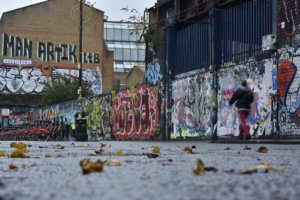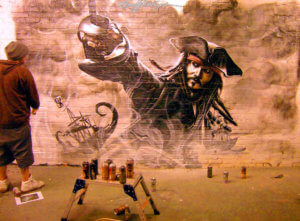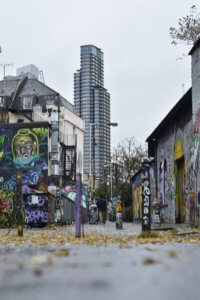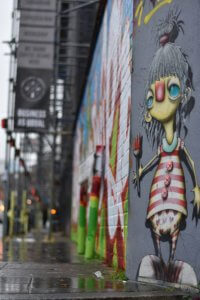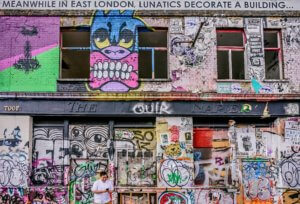Urban Explorer Series: Interview with Darren Cullen
“I feel like London is ME, it created me.”
Darren Cullen
Founder and Owner of Graffiti Kings
Our Urban Explorer
Could you please introduce yourself to our guests?
I’m Darren Cullen, a professional graffiti artist and founder of Graffiti Kings, a collaboration of graffiti artists, street artists, animators, film makers, illustrators, music producers, DJs, event planners, digital and street marketers.
How do you think you fit into the term “Urban Explorer”?
I’ve explored places in London that most people don’t even know about, places where you aren’t allowed to go. I know London from behind the scenes, the forgotten tunnels and streets, and my work has connected me with such a wide range of Londoners.
What do you love most about London?
I love how diverse this city is, there are so many different cultures mixed together, which as a creative is amazing. The amount of artwork now is crazy, when I was growing up in the 90’s it was just UK artists, but now it’s like a worldwide gallery. I feel like London is ME, it created me.
What makes London so unique in your view?
All the different cultures just mix and get on with each other, it seems more free than other cities I’ve been to.
What does a day in the life of Darren Cullen, graffiti artist, look like?
At the moment, I’m filming and trying to move to a new house, and there are not enough hours and arms in the day! But normally, I’ll get around 5 hours of sleep, wake up at 6am and do some email administrative work, then do a bit of exercise and then some more admin work until around 9am. Then, I’m running around the UK to various locations where we have work starting or ongoing – I’m overseeing work and making sure the clients are happy and the artists have everything they need.
How did you get into the graffiti art scene?
When I was 10, a couple of school friends went to New York on a family trip, and when they came back, they showed us photos of trains and walls with all this artwork on it. I’d seen graffiti on walls in Croydon, where I grew up, but had no understanding of what it was, just colourful things. These friends explained that it was ‘tags’, using spray cans, and that was it…the virus grew! From that day we were writing on the classroom floor with chalk and crayons, just writing nicknames with no particular purpose. Every couple of days, I had a new name! Then I went to senior school and started to find other people who did graffiti, drawing on books and the like, and our little community grew and grew. Most weekends, we would hang out in Croydon at places with graffiti on the walls, and bump into other people interested in it.
At what point did it become a career rather than a hobby?
Early on, when I was a teenager, I was commissioned to paint the wall of a play centre in Croydon, and from there I worked on various private commissions. I taught workshops at the youth club in Mitcham, and after being asked to teach by other council youth services in Croydon, Sutton and Lambeth, and struggling to find the time, I started asking my friends to teach as well and so Graffiti Kings was formed. At one point, the manager of West Croydon train station came into the youth club asking for me by name – he was having a problem with local kids vandalising his station, and rather than involving the police he wanted to take a different approach. He asked us to paint the outside of Wallington train station! So we did, and a few months later he got in touch and said the public loved our murals. This has allowed us to do more. The train company Connex employed me full-time painting stations with the kids previously responsible for vandalising their stations. A year later, Railtrack and Thameslink also employed me to do the same thing, working with ‘vandals’ to paint stations. Local authorities noticed that graffiti vandalism in the areas I was working had seen a massive drop, and put this down to the project, which was engaging with the ‘vandals’ on a level they understand. This is what led to me being endorsed by the government, and the go-to man to advise local authorities on graffiti problems.
How do you think graffiti culture in London has evolved from when you started at age 10 to now?
It has evolved very positively. It is much, much more colourful now and more organised. Back in the day, it was very hard to meet like-minded people, and the only influence we had was from local artists and MTV hip hop videos which showed graffiti in them. Once the internet arrived, graffiti had a flurry of evolving rapidly, with the likes of Banksy, Shepard Fairy and D*Face coming along in the late 90s. They made graffiti a hot topic, painting huge walls with images that people can relate to – pictures rather than lettering. The perception of graffiti gradually changed from vandalism to artwork, like a beautiful butterfly! But if it wasn’t for the guys in the 70’s vandalising walls and trains, it would never have evolved.
Do you take any influence from London culture and/or history when creating your artworks?
Personally, yes, all areas of London have their own style, and I’ve noticed that artists who move to the area really change and evolve to the London scene after a while. The ‘90s rave culture had a big influence on graffiti art, and music has continued to influence it I think.
Can you walk us through the creative process of producing graffiti art for a client? The general steps and processes in order to bring it to life.
First, we take a brief from the client, then the team walks away and brainstorms over it, coming up with out-of-the-box ideas that the client has never even considered. We like to chuck some curve balls in there! Then, we nail it down to something more concrete, create a draft, go back and forth with the client and then once we have an approved design we need to assess where it will be painted. Canvases range from bedroom walls, to offices, to 10m high walls requiring scaffolding. This obviously affects how long the project will take, and equipment needed.
How do you want to inspire people through your art? Who inspired you?
I don’t intentionally go out to inspire, but if I do – that’s great! I’m just doing me, what I want to do. When I was younger, trying to please people took over my life and squashed my artistic side. I was initially inspired by a book – ‘Subway Art’ (1985). My friends and I would sit in Mitcham Road library for hours drawing and copying all the artworks from this book. It included graffiti by Seen, Futura 2000, DONDI, Skeme, LEE and Lady Pink.
Do you have a London influencer, artist, photographer, notable person who you most admire?
I recently met photographer Jamie Drew (@jdshotyou), he’s a young guy doing some great things already, a real grafter. He’s using Instagram to reach out to people and network, his stuff is really wow, such a great role model for my kids.
Do you feel like your profession allows you access to otherwise unseen parts of London and are there any secrets you can tell us about these hidden gems?
In the ‘80s, there were a lot of abandoned buildings around, that would stay that way for ages and attract graffiti, but nowadays they’re all developed so quickly. The subway tunnels still tend to attract graffiti, for example at Elephant and Castle. You’ll see locked doorways in them that hide tunnels ending up on the tube tracks.
Can you share any interesting people or stories that you have come across in your work that really left an impression on you?
Back in 2008 I met a guy called Rich Simmons (@richsimmonsart), who got in touch when we opened the new Graffiti Kings studio in London. His artwork had great potential, and he was trying to do it full-time. I advised him to get off the sofa and get to London! He came down and at one point lived in our old studio for a few years. When he arrived, he looked like he wasn’t sleeping, looked awful, told us stories of self-harming. We all encouraged him and helped him out, and a few years later he left to pursue his own thing – now he’s all over the world and classed as the next Banksy. He’s set up ‘Art is a Cure’, and speaks to people with problems, sharing his life story and how art has helped him and others. He tells people to pick up a spray can, go into your garden and just paint a wall. He’s made a movie to spread his message. From what he was to what he’s done now, painting galleries all over the world and trying to help other people, is cool. He’s now influencing us!
How often do you travel? Do you travel more for work or pleasure?
Usually, once a month I go abroad and most weekends we’ll go somewhere in the UK just to get away. Travelling is always a pleasure for me! But I always give a bit of time to documenting my travels, building up a catalogue of where we’ve been and what we’ve done.
Where does your inspiration for travel come from?
I’m lucky that I get to speak to lots of different people through my work and hear their recommendations. I’m always in search of ‘different-ness’, show me something different that’s going to make my brain think.
What destinations are on your bucket list?
Warsaw, I really want to go there soon, I’ve been hearing about it for ages. Also, Hong Kong!
Which places or areas of the city do you enjoy hanging out at most and why?
East London for sure, it’s so creative. Hoxton is really cool, and Hackney up the road is pretty good too. Creatives are very outgoing people, and like to express themselves, so I recommend heading to creative hotspots like Hoxton even if you’re not creative, just for the experience. Follow the graffiti!
Which areas of London most inspire your work? Why?
Again, East London – for the creativity. There’s so much going on, art galleries everywhere, little breweries and independent shops everywhere. It’s a bit crazy. Everything is independent, which is inspiring. Creative people selling their creations, whether it’s a book or clothing. These people have got off their sofas and opened a shop to sell their wares…come on, this is beautiful!
Which area in London would you recommend first-time visitors to explore for a nice city walk?
I’m going to say it again…East London! Also, Soho has lots going on; it’s everything that London has always been, from the seedy side to quirky bookshops and great bars and restaurants. There’s some nice street art going on too, Mr Cenz (@mrcenzone) has painted some great walls there. If you get bored in Soho, something’s wrong!
What must-have items do you carry with you when you go exploring in London?
My backpack just has my phone, waterproofs (so essential in the UK!) and a bottle of water.
Being a London local, can you tell us 3 restaurants you think embody the city and really offer something different to the big-name restaurants?
Pidgin in Hackney serves a weekly set menu of modern European food. Apparently, in over three years they’ve never repeated a dish!
Burger & Beyond in Shoreditch does the most epic sloppy burgers. You need to go hungry so you can enjoy all the extras – such as ‘dirty tots’ and lamb croquettes.
Cowcross Yards is near Farringdon Station, not exactly a restaurant but an eating and drinking hub with food markets and pop up restaurants and events. And you might spot some Graffiti Kings artwork whilst you’re there.
Favourite bar?
Sager + Wilde on Hackney Road, a cool neighbourhood wine bar with exposed brick walls and wooden floors. And an extensive wine list!
Favourite shopping area?
The markets at the Old Truman Brewery on Brick Lane in East London are great. The Backyard Market runs on Saturdays and Sundays, with a real community spirit and supports young designers and artists. On Sunday the Upmarket has a big indoor food area, and about 200 stalls with a focus on up and coming designers and artists.
Favourite place for a Saturday morning stroll?
You can’t beat a stroll along the Thames, starting at Chelsea Bridge and heading east until you get tired! Stay on the south side, and you’ll pass Southbank, the Tate Modern and the Globe, and have a great view of landmarks on the north side.
Where to go to find something a little different?
In East London, everything’s different, totally different. Do the rest of London first – Big Ben, the tourist spots, and once you’ve done with that jump on the tube East and you won’t want to go home!
Any final top tips, recommendations, must see places worth noting?
Leake Street Arches under Waterloo station. London’s longest legal graffiti wall is here, you can turn up at any time of the day and paint, no worry or stress. The graffiti has drawn investment in, and now it’s a whole community of independent restaurants, bars and entertainment united by the creativity of urban culture. Get down there around 3pm on a Saturday afternoon and you’ll be like, wow. A few years ago it was a dirty, drippy tunnel and now it’s so vibrant – transformed by graffiti!
